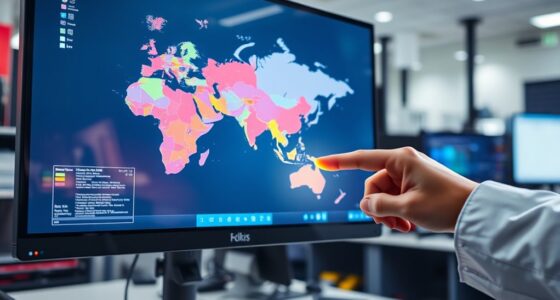In the world of finance, navigating the complex maze of regulatory compliance is akin to mastering a difficult game of chess. Each move requires strategic thinking and a thorough understanding of the rules.
As we explore the realm of financial compliance training programs, we uncover a treasure trove of knowledge and expertise that can elevate professionals to the ranks of compliance champions.
From the latest technological advancements to the evolving regulatory landscape, these programs offer a glimpse into the arsenal of tools designed to equip individuals and organizations with the prowess to navigate the ever-changing world of financial compliance.
Key Takeaways
- Significant annual growth is expected in the financial compliance training market from 2023 to 2030.
- The market is driven by strategic initiatives of key players and the increasing need for risk management.
- North America leads the global compliance training market, followed by Europe, Asia-Pacific, South America, and the Middle East and Africa.
- Top financial compliance programs offer comprehensive content, interactive learning methods, industry expert instructors, customization options, and certification/accreditation by relevant bodies.
Overview of Financial Compliance Training Programs
In our review of financial compliance training programs, we’ve observed significant annual growth expected from 2023 to 2030, driven by strategic initiatives of key players and segmented into offline and online learning.
The market for compliance training programs is poised for substantial expansion, primarily due to the increasing need for risk management and the direct impact of regulatory requirements on financial institutions. This growth is further fueled by technological advancements, particularly the shift towards online learning platforms. The COVID-19 pandemic has also played a significant role, influencing the forecasted market size of USD million by 2028.
Major players such as Lorman Education Services, Thomson Reuters Corp., ProBank Austin, Financial Industry Regulatory Authority Inc., and Euromoney Learning are at the forefront, providing essential data, information, and competitive landscape details.
Notably, the global compliance training for financial institutions is led by North America, followed by Europe, Asia-Pacific, South America, and the Middle East and Africa, showcasing a regional market leadership pattern.
The market competition and size are rigorously analyzed, considering factors such as revenue and share by players, market concentration rate, market share by type and application, market competition trend, and market size by country.
Key Features of Top Financial Compliance Programs

Amid the rapid growth projected for financial compliance training programs, a keen focus on the key features of top programs emerges as a critical determinant of their effectiveness. When evaluating financial compliance training programs, it’s essential to consider the key features that set them apart. Here are the key features of the top financial compliance programs:
| Key Features | Description |
|---|---|
| Comprehensive Content | Well-rounded coverage of regulatory requirements, risk management, and industry best practices. |
| Interactive Learning | Engaging and interactive training methods such as case studies, simulations, and real-world scenarios. |
| Industry Expert Instructors | Qualified instructors with extensive experience in financial compliance and regulatory affairs. |
| Customization Options | Flexibility to tailor the training to specific organizational needs and regulatory environments. |
| Certification and Accreditation | Recognition by relevant regulatory bodies and industry associations, ensuring the program’s credibility and relevance. |
These key features are essential for ensuring that financial compliance training programs meet the diverse needs of organizations and professionals in the ever-evolving regulatory landscape. As the market for compliance training continues to expand, understanding these features becomes increasingly crucial for selecting the most effective program.
Program 1: Review and Analysis
Our review and analysis of Program 1 on Compliance Training for Financial Institutions offers valuable insights into market trends and the anticipated growth trajectory from 2023 to 2030.
This program provides a comprehensive understanding of the impact of the COVID-19 pandemic on the market, including the forecasted readjusted size by 2028.
By delving into the key players and company profiles dominating the Compliance Training for Financial Institutions market worldwide, participants can gain a deep understanding of the competitive landscape.
Additionally, the program equips learners with knowledge about global Compliance Training for Financial Institutions revenue and market share by players, type, and application, enabling them to make informed strategic decisions.
This analysis is crucial for professionals seeking to navigate the complexities of financial compliance and stay ahead in a rapidly evolving market.
Program 2: Review and Analysis

Program 2: Review and Analysis offers an insightful examination of financial compliance regulations and best practices, providing a comprehensive evaluation of market trends and forecasts for the Compliance Training for Financial Institutions industry.
This program delves into the intricate details of key players and their impact on the market, presenting a thorough analysis of global market competition and the market share of top players.
It also includes a regional market leadership assessment covering North America, Europe, Asia-Pacific, South America, and the Middle East and Africa.
The depth of review and analysis provided by Program 2 equips professionals with the knowledge and understanding necessary to navigate the complexities of financial compliance within the dynamic landscape of the industry.
By offering a detailed exploration of market trends and forecasts, this program empowers individuals to make informed decisions and implement effective strategies to ensure compliance with regulations and best practices.
It’s a valuable resource for those seeking mastery in the Compliance Training for Financial Institutions sector.
Program 3: Review and Analysis

Let’s examine the key features and the overall impact of Program 3: Review and Analysis.
This program provides an in-depth review and analysis of the Compliance Training for Financial Institutions market globally, including detailed insight into market growth trends and forecasts from 2023 to 2030.
We’ll also focus on key market segments such as applications (Offline Learning and Online Learning) and types (Professional Courses and Introductory Courses), and evaluate the impact of technological advancements, regulatory requirements, and risk management on market growth.
Program Overview
In reviewing and analyzing the Compliance Training for Financial Institutions industry, Program 3 provides a comprehensive examination of market trends, competition, and anticipated growth factors from 2023 to 2030.
This program offers a detailed insight into the expected market growth rate and the driving forces behind it. It thoroughly covers the segmentation of the market by applications (Offline Learning and Online Learning) and types (Professional Courses and Introductory Courses).
Additionally, Program 3 delves into the global market size, estimated worth in 2022, and the adjusted size due to the impact of the COVID-19 pandemic by 2028. Furthermore, it provides a thorough analysis of the market’s segmentation by region, players, type, and application, offering revenue and forecast analysis for a specified period.
Key Features
We thoroughly examined the key features of Program 3, shedding light on its comprehensive skill set and suitability for beginners within a 3-6 month completion timeframe.
This program offers a wide range of skills, including data analysis, R programming, SQL, and business communication, providing a strong foundation for financial compliance training.
The high ratings of both Google Data Analytics and IBM Data Science courses indicate the quality of training participants can expect. Additionally, the opportunity to receive credit for completing the program adds further value.
Its beginner-friendly nature and relatively short duration make it an attractive option for those looking to enter the field or upskill.
The program’s focus on reviewing and analyzing financial compliance training in the market ensures that participants gain a thorough understanding of industry practices and standards.
Training Impact
Program 3’s review and analysis will delve into the market impact and key players within the Compliance Training for Financial Institutions industry. To provide a clear snapshot of the industry landscape, we have compiled a table detailing the market growth, key players, revenue, and market share trends in the Compliance Training for Financial Institutions industry.
| Market Growth & Trends | Key Players | Revenue & Market Share | Regional Market Leaders |
|---|---|---|---|
| 2023-2030 Analysis | Company A | 2019-2023 Evaluation | North America Leader |
| Company B | Europe Leader | ||
| Company C | Asia-Pacific Leader | ||
| Company D | South America Leader | ||
| Company E | Middle East & Africa Leader |
This comprehensive analysis aims to provide valuable insights into the market dynamics and help industry professionals make informed decisions.
Program 4: Review and Analysis

Let’s examine the key points of Program 4:
- Overview: This program promises a comprehensive review of the Compliance Training for Financial Institutions market, including its growth prospects and market trends.
- Training Content Analysis: This program offers an in-depth analysis of the key players and company profiles within the market, providing valuable insights for professionals in the financial compliance sector.
- Effectiveness Assessment: This program also includes an assessment of the effectiveness of compliance training programs in financial institutions, helping organizations gauge the impact of their training initiatives.
These three components of Program 4 combine to provide a holistic view of the compliance training landscape in the financial industry, equipping professionals with the knowledge and insights they need to make informed decisions and drive compliance excellence.
Program 4 Overview
In our review of Program 4, we focus on the analysis of the Compliance Training for Financial Institutions market, examining market growth, segmentation, and key player performance.
This program delves deep into the intricacies of the market, providing learners with comprehensive insights that are essential for mastering financial compliance.
The program’s in-depth examination of market competition trends equips learners with the knowledge to navigate the competitive landscape effectively.
Learners will gain a thorough understanding of market segmentation by region, type, and application, enabling them to make well-informed decisions.
Additionally, the analysis of revenue and market share of key players offers valuable perspectives for professionals aiming to excel in the financial compliance domain.
Through this program, learners will gain a clear understanding of the regional market leaders in Compliance Training for Financial Institutions.
Training Content Analysis
Our analysis of the Training Content in Program 4 provides a comprehensive overview and in-depth examination of compliance training for financial institutions.
The program covers market trends, growth forecasts, and market competition in the sector. Learners will gain insights into market leaders, key players, and company profiles in the compliance training for financial institutions market.
The program includes a detailed analysis of global market size, revenue, and market share by type and application. It equips learners to understand regional market dynamics and leaders in the compliance training for financial institutions industry.
This thorough analysis empowers professionals to grasp the intricacies of the compliance training landscape, enabling them to make informed decisions and stay ahead in the competitive financial compliance sector.
Effectiveness Assessment
The assessment of Program 4’s effectiveness in compliance training entails:
- Scrutinizing the impact on employee behavior and organizational culture.
- Analyzing training outcomes to ensure it achieves its objectives.
- Reviewing training materials, delivery methods, and participant feedback.
- Striving to make a positive impact and optimize training effectiveness.
- Aiming to identify areas for improvement and ensure compliance training is effective.
Frequently Asked Questions
What Is BAI Compliance Training?
BAI Compliance Training is a crucial program for financial professionals. It ensures understanding and adherence to regulatory requirements and risk management. Its significance stems from the increasing need for compliance training in financial institutions and technological advancements in training.
This program addresses regulatory requirements and the digitization of training programs in the financial sector. Key players in this market include Lorman Education Services, Thomson Reuters Corp., ProBank Austin, and Financial Industry Regulatory Authority Inc.
How Often Should You Receive Compliance Training?
We should receive compliance training annually to keep up with regulatory changes and industry best practices.
It’s essential to stay informed and reinforce knowledge on ethical standards and legal requirements.
Whenever there are significant regulatory changes, updates in the industry, or changes in job roles or responsibilities, it’s recommended to receive compliance training.
Regular training is necessary for maintaining up-to-date and relevant information.
What Is Bai Learning Manager?
Bai Learning Manager is a comprehensive financial compliance training program, tailored to the needs of compliance professionals in the financial industry.
It focuses on regulatory requirements, risk management, and technological advancements.
We equip compliance professionals with the necessary skills and knowledge to navigate the complex landscape of financial regulations and ensure adherence to industry standards.
This program addresses the growing demand for compliance training in financial institutions, driven by the need for effective risk management and regulatory compliance.
How Can I Become a Compliance Officer in Uae?
To become a compliance officer in the UAE, we need relevant qualifications like a finance, business, or law degree.
Acquiring professional certifications such as CRCM or CAMS can enhance our career prospects.
Gaining practical experience through internships or entry-level positions in financial institutions is crucial.
Understanding UAE’s regulatory framework and networking with industry professionals while staying updated on compliance trends are also essential for aspiring compliance officers in the UAE.
Conclusion
In conclusion, the financial compliance training programs reviewed in this article are like a compass guiding financial institutions through the complex and ever-changing landscape of regulations and requirements.
With their comprehensive features and expert analysis, these programs serve as valuable tools for staying ahead of the curve and ensuring adherence to compliance standards.
As the market continues to grow, it’s crucial for organizations to invest in top-notch training programs to navigate the regulatory environment effectively.
Randy serves as our Software Quality Assurance Expert, bringing to the table a rich tapestry of industry experiences gathered over 15 years with various renowned tech companies. His deep understanding of the intricate aspects and the evolving challenges in SQA is unparalleled. At EarnQA, Randy’s contributions extend well beyond developing courses; he is a mentor to students and a leader of webinars, sharing valuable insights and hands-on experiences that greatly enhance our educational programs.









